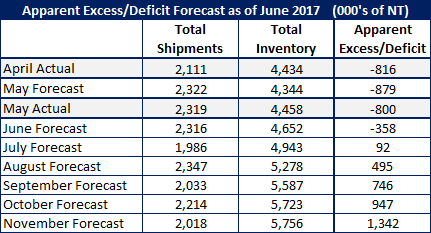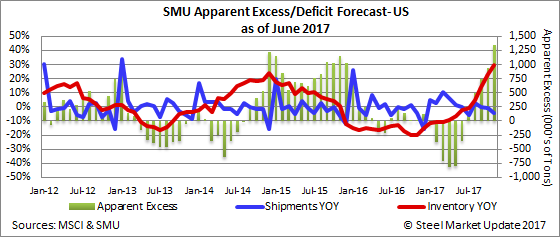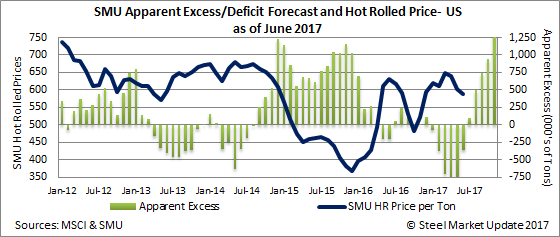SMU Data and Models

SMU Apparent Excess/Deficit Forecast Nails Shipments/Deficit Shrinks
Written by John Packard
June 21, 2017
Last month Steel Market Update forecast steel shipments of carbon flat rolled would total 2,322,000 tons and, according to the MSCI data released last week, shipments were 3,319,000 tons. We missed the number by 3,000 tons…
Our forecast called for flat rolled inventories to total 4,344,000 tons at the end of May. We were off by 214,000 tons as inventories came in higher at 4,458,000 tons.
![]() Based on the SMU Service Center Inventories Apparent Excess/Deficit model we calculated distributors were short 800,000 tons (our forecast was slightly higher deficit at -879,000 tons). We ended the month of April with a deficit of -816,000 tons.
Based on the SMU Service Center Inventories Apparent Excess/Deficit model we calculated distributors were short 800,000 tons (our forecast was slightly higher deficit at -879,000 tons). We ended the month of April with a deficit of -816,000 tons.
All of these numbers are based on MSCI data and the assumption the numbers are accurate. Our own surveys and interactions with service centers are raising question as to whether the deficit is as large as our model is showing. For now, we do not have an alternative to the MSCI numbers and thus we are coming to the same conclusion that most of the domestic steel mills are making – service centers need to build back inventories.
June 2017 Forecast
Our forecast for the next few months is that shipments will be within the 4-year average putting June at 2,316,000 tons (almost exactly the same as May 2017).
Inventories of flat rolled will end the month up another 200,000 tons as we expect the month to end with 4,652,000 tons and the Apparent Deficit will, if we are correct, decline to -358,000 tons.
Here is what we are forecasting through November 2017:




John Packard
Read more from John PackardLatest in SMU Data and Models

SMU Scrap Survey: Sentiment Indices rise
Both current and future scrap sentiment jumped this month, though survey participants reported responses before key trade news was announced.

SMU Survey: Sentiment splits, buyers have better view of future than the present
SMU’s Steel Buyers’ Sentiment Indices moved in opposite directions this week. After rebounding from a near five-year low in late June, Current Sentiment slipped again. At the same time, Future Sentiment climbed to a four-month high. Both indices continue to show optimism among buyers about their company’s chances for success, but suggest there is less confidence in that optimism than earlier in the year.

SMU scrap market survey results now available
SMU’s ferrous scrap market survey results are now available on our website to all premium members. After logging in at steelmarketupdate.com, visit the pricing and analysis tab and look under the “survey results” section for “ferrous scrap survey” results. Past scrap survey results are also available under that selection. If you need help accessing the survey results […]

SMU flat-rolled market survey results now available
SMU’s latest steel buyers market survey results are now available on our website to all premium members. After logging in at steelmarketupdate.com, visit the pricing and analysis tab and look under the “survey results” section for “latest survey results.” Past survey results are also available under that selection. If you need help accessing the survey results, or if […]

SMU Survey: Sheet lead times stabilize, plate contracts
Mill lead times for sheet products were steady to slightly longer this week compared to our late June market check, while plate lead times contracted, according to steel buyers responding to this week’s market survey.
